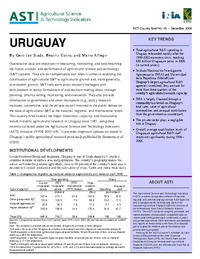Authors:
Stads, Gert-Jan; Cotro, Beatriz; Allegri, Mario
Year:
2008
Publisher
International Food Policy Research Institute (IFPRI); and Instituto Nacional de Investigación Agropecuaria (INIA)
Back to:
In 2006, Uruguay employed roughly 400 fte researchers and spent 848 million Uruguayan pesos (in current prices) on agricultural research. INIA’s funding structure is unique in Latin America in that it receives the proceeds of a commodity tax levied on the total sales value of agricultural commodities in Uruguay and an equal contribution from the national government as counterpart funding. In light of this, INIA is highly dependent on the total production value of Uruguay’s agricultural sector. During 1999–2003, the country underwent the worst economic crisis in its recent history, which in turn led to a contraction of agricultural output and, as a result, overall funding to INIA. In 2004, Uruguay's economy began to recover, resulting in rapidly rising agricultural R&D spending.
Uruguay compares favorably with many of its Latin American counterparts in a number of key agricultural S&T indicators. For example, its agricultural research expenditures as a share of AgGDP (at close to 2.0 percent) are much higher than in other Latin American countries. It is important to note, however, that in order to make a proper assessment of the importance of agriculture to Uruguay’s economy, it is necessary to take agribusiness linkages into account. The resulting indirect role of the agricultural sector in the overall economy is therefore much larger than official AgGDP data indicate, so the country’s high agricultural research intensity ratio should be assessed from this perspective.

